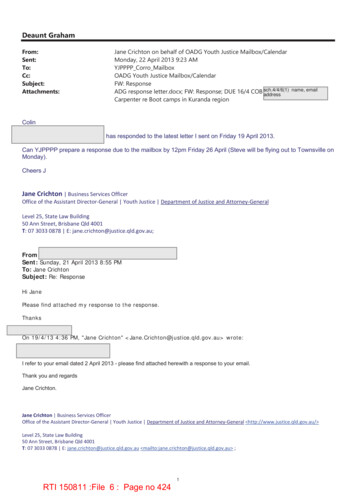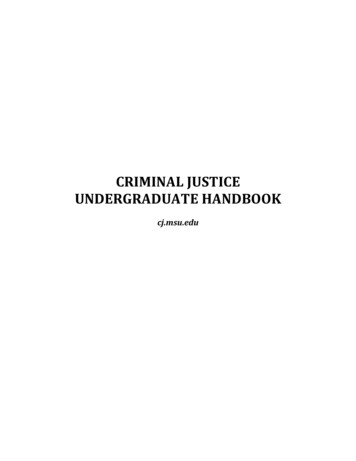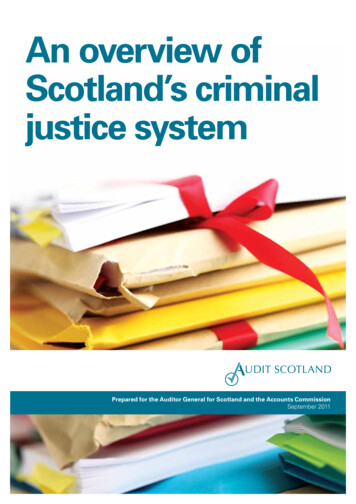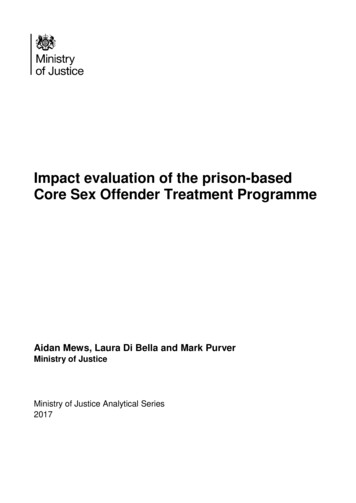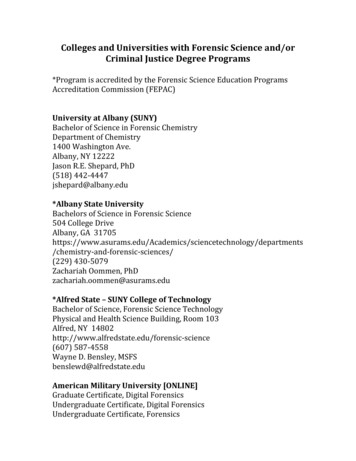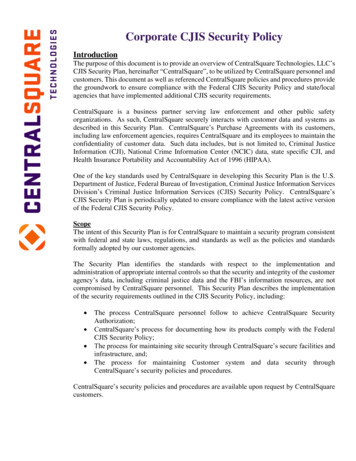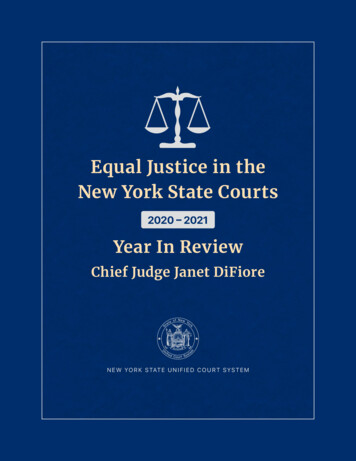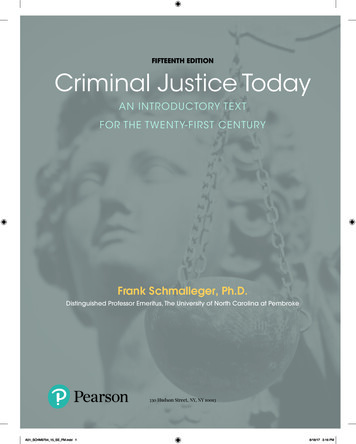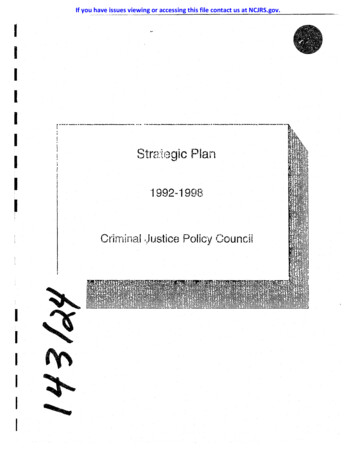
Transcription
If you have issues viewing or accessing this file contact us at NCJRS.gov.IIII,IIII; T -,-- - - - - - - - - - - - - - - .-.------ --.- . - . - - - - - . - - - - . , . - - - - - - - - ,;,,I!II,,!,J ! '1992-19fJ8Crirn nalIIIIIq."JusticE: Policy CouncH
'JIIIIIIIIIIIIIIIIIIAgency Strategic PlanFor the 1992-1998 PeriodbyCriminal Justice Policy CouncilHonorable Ann Richards, GovernorHonorable Bob Bullock, Lt. GovernorHonorable Gib Lewis, Speaker of the HouseHonorable Ted Lyon, SenateHonorable Gene Green, SenateHonorable Allen Hightower, HouseHonorable Barry Telford, HouseHonorable Sam Russell, HouseHonorable Alan Place, HouseSheriff Sonny KeeseeSheriff Jim BoutwellHonorable Victor TrevinoCol. James AdamsChairpersonVice-chairVice-chairStatutory appointmentAt pleasure of Lt. Gov.Statutory appointmentAt pleasure of SpeakerStatutory appointmentAt pleasure of SpeakerAt pleasure of GovernorAt pleasure of GovernorAt pleasure of GovernorAt pleasure of GovernorApril 1, 1992 Signed:Tony FabeloExecutive Director, Criminal Justice Policy CouncilApproved: -.:. - ::::.::.: : -.t:.-C .(Governor Ann W. RichardsChair, Criminal Justice Policy n
143124U.S. Department of JusticeNational Institute of JusticeThis document has been reproduced exactly as received from theperson or organization originating it. Points of view or opinions stated inthis document are those of the autrors and do not necessarily representthe official position or policies of the National Institute of Justice.Permission to reproducegranted byt .lscopyrighted material has beenTexas Criminal Justice PolicyCouncilto the National Criminal Justice Reference Service (NCJRS).Further reproduction outside of the NCJRS system requires permissionof the copyright owner.IIIIIIIIIIIIIIIIIII
------------- IWe enVISion a Texas where all people have the. skills andopportunities they need to achieve their individualdreams; a Texas where people enjoy good health, are safeand secure fiOm harm, and share a quality standard ofliving; a Texas where we and future generations can enjoyour bountiful natural beauty and resources. IIFrom: Texas Tomorrow1
IIIIII- IIIIIIIIIIIIIStatewideFunctionalGoals."We will provide the prison space we need to remove violentoffenders from our streets. II"We will reduce recidivism through substance-abuse programs,education and vocational training. 1I"We will develop cost-effective community-basedoffenders. IIprograms for"We will reduce violent drug- and gang-related crime by focusing ondrug-interdiction, law enforcement and prosecution.1I"We will support programs that demonstrate new and effective waysto reduce the number of children entering or reentering the juvenilejustice system.""We will minimize the trauma suffered by victims of crime.""We will reform our criminal laws so that offenders receive swiftand just punishment."IIWe will work to end federal court control over our prison system byending the 18-year old Ruiz lawsuit. II"Our judicial system will operate quickly, efficiently and fairly inmeting out justice."From: Texas Tomorrow2
II-Mission'11' . , .IIIIIIIIIIIIIIIIIThe mission of the Criminal Justice Policy Councilis to conduct strategic research, planning and programevaluations to identify the long-range needs and criticalproblems in the criminal justice system. Our mission isto develop analyses based on the best availableinformation to help the Governor and the Legislature indeveloping plans, programs, and proposed legislation forimproving the effectiveness of the criminal justicesystem.3
IIIIIIIIIIIIIIIIIIIPhilosophyThe Criminal JU lce Policy Council will conduct strategicplanning, policy research and program evaluations responsive to theneeds of policy makers while maintaining the validity, integrity andcredibility of the information. The Criminal Justice Policy Councilwill : Act as an expert resource to policy makers bydeveloping choices based on scientific information thatexplicitly present the assumptions used in policyanalyses. Develop models to aid in the most effectiveimplementation of policies adopted by the Governor andthe Legislature.Use the best expert judgment to maintain andpromote the credibility and integrity of the work done bythe agency.e Maintainhighest standards.excellencebystrivingforthe Conduct all agency activities efficiently andcost-effectively. Demand the highest ethical standards in theconduct of all the activities of the agency.4
IIIIIIIIIIIIIIIIIIIExternalll nternalAssessmentOverview o'f Agency Scope and FunctionsThe Criminal Justice Policy Council activities are directed atdeveloping and improving the state criminal justice informationsystems for law enforcement, courts, and correctional purposes aswell as for policy analysis.The complexities of managing andevaluting a large criminal justice agency or system puts increasingdemands on executive and legislative policy makers to maximizeresources through the better utilization of information. Informationis critical for generating awareness of needs, problems, andshortcomings in services and to generate strategies to deal withthese needs.The Criminal Justice Policy Council works in three areas tohelp the state policy makers in the enactment of more effectivepolicies and in the evaluation of the implementation and impact ofpolicies adopted.CriminalJusticeInformationAuthorityThe Criminal Justice Information Authority activities of theCriminal Justice Policy Council seek to improve data andinformation systems for law enforcement, courts and corrections.Designing the Texas Criminal Justice Information System andplanning for its implementation with the Texas Department ofPublic Safety and the Texas Department of Criminal Justice andstreamlining paper reporting requirements imposed by the state onlocal governments are the most recent examples of activities in thisarea.The Criminal Justice Policy Council plays a key role in thedesign and implementation of the Texas Criminal JusticeInformation System(TCJIS). This systemwillprovidestate-of-the-art offender tracking information and a wealth of5
IIIIIIIIIIIIIIIIIIIinformation for policy analysis and strategic planning. The CriminalJustice Policy Council builds linkages between local, state andnational experts to support the design .and implementation of acost-effective information sharing system. A successful model forthe electronic transmission of court disposition information to theTCJIS has been tested and integrated in the implementation of thesystem.Electronic reporting will make' ····criminal . historyinformation more reliable and will gre,, tly reduce the need for paperreporting between the localities and the state. The Criminal JusticePolicy Council also works to develop and implement analyticalmodels to use the information in the TCJIS for the management ofthe criminal justice system and to enhance analyses f0r ResearchThe Statistical Analysis and Evaluation Research activitiesseek to use the data available in the state criminal justiceinformation systems or gather new information, if necessary, toprovide criminal justice managers and state policy makers withprogram evaluations and policy analysis.The Criminal Justice Policy Council develops models for theeffective use and application of information for policy making andstrategic planning. The JUSTICE model, for example, provides asimple but comprehensive framework to analyze criminal justiceoffender based and proceSSing information. The model serves thestate leadership in projecting the impact of sentencing policies onthe correctional system and in developing alternate pOlicies.Projections generated by JUSTICE are used by the Texas Departmentof Criminal Justice - Institutional Division to develop theirstatutorily mandated four year construction plans.Long-term process and outcome evaluations of criminaljustice programs are conducted to measure the effectiveness of newinitiatives. This is particularly important·· because budgetconstraints demand the better utilization of lim ited state6
II-IIIIIIIIIIIIIIIIIresources.following:Example ofon goingprogram evaluations are theEnhanced Drug Treatment Program in the Boot Camp ofthe Texas Department of Criminal Justice - Institutional Division.Computer assisted offender education program "Readingto Reduce Recidivim."Employment Services for Probationers program.Treatment Alternative IncarcerationTexas Commission on Alcohol and Drug Abuse.Drug law enforcementNarctotics Control Program. tateLeadershipPolicytaskProgram· by theforcesbyDevelopmenttheTexasAssistanceThe Criminal Justice Policy Council has nationally recognizedstaff that routinely provides assistance to the state leadership forpolicy development. This help is provided through special projectsassigned by the legislature or through assignments by the Governor.llIlResource to the Office of the Governor. The CriminalJustice Policy Council provides the Office of the Governor withanalyses of policies under consideration or analyses for developingpolicy initiatives.Special reports or memorandum are prepared asneeded by the Governor's staff in their policy development.Presently, the office is developing on behalf of the Governor'sOffice, Criminal Justice Division, the plans required by the federalgovernment for the expenditures of federal formula grant funds toimprove the state's criminal history information.Resource to the Legislature. Interim "special projects"are conducted for the legislature. For the 1992-1993 biennium theCriminal Justice Policy Council is conducting the mostcomprehensive study of sentencing patterns ever done in the state7
II IIIIIIIIIIIIIIIIIand is also helping the Texas Punishment Standards Commission indetermining the effect on the correctional system of proposedchanges in sentencing policies.During legislative sessions, and atthe request o'f the Lt. Governor, the Speaker of the House or the chairof a legislative committee, the Criminal Justice Policy Council willdevelop an impact statement on legislation affecting the adultcorrectional system.The policy impact analyses of the CriminalJustice Policy Council supplements the fical notes developed by theLegislative Budget Office.8
IIIIIIIIIIIIIIIIIIIExternalFactors. Key Trends Influencing SuccessIn the 1990's, the state faces a crossroad in criminal justicepolicy in which policy makers will have to design more responsivepolicies to deal with crime and criminal justice. Increasing violentcrime and increasing arrests in the late 19-80's and early 1990'shave led to more convictions for adult felony cases in Texas. Therising number of convictions has increased the pressure for morecapacity in community corrections and the prison system.In the late 1980's prison capacity has not supported thedemand for prison space. Therefore, convicted felons sentenced toprison who have not been admitted because of lack of prison spacehave remained in a "backlog" of inmates residing in county jails andawaiting transfer to prison. Chart 1 below describes the historicalgrowth in the backlog.Chart 1: Offenders Awaiting Transfer toPrison in County Jails - Jail Backlog2000014,69510000oNov. 87 Sept. 88 Sept. 89 Sept. 90 Sept. 91 March 929
IIIIIIIIIIIIIIIIIIIFunding for building over 40,000 new prison beds andcommunity corrections substance abuse treatment beds has beenauthorized since 1987 and these, beds should be operational. .by. 1996.The total correctional bed capacity will have increased by 250.6%between 1980 and 1996. The prison capacity in 1996 will be 81,178beds with an added 12,000 community corrections substance abusetreatment beds for a total state bed capacity of 93,178. Despitethis increase, however, preliminary projections done by the CriminalJustice Policy Council show that given no change in present pOlicies,the backlog of state prisoners in county jails will continue toincrease.As seen in Chart 2 below, the prison admission pressure isprojected to exceed the actual prison admissions possible given allavailable correctional capacity.Chart 2:Prison Admissions vs. Admission PressureActual 85-91 - Projected 92-9880000Actual admsPressure60000Actual admissionsat 150 per day4000020000o85868788899091 92939495969798FY10
IIIIIIIIIIIIIIIIIIIThe backlog of state prisoners in county jails is projected toincrease as seen in Chart 3. By fiscal year 1998, the jail backlogcan range from 10,741 inmates to 24,637, ··depending on prisonrelease policies.Chart 3: Projected Jail Backlog of State PrisonersSummary - Impact of Different Release Policies30000 995199619971998FYThe fiscal implications of the projections are substantial.Projected payment to counties under the provisions of House Bill 93can go as high as 359 million by the end of the 1994-1995biennium. The projected added capacity cost in General Revenue todeal with the jail backlog after fiscal year 1995 can be as high as 751 million. This amount will double if bonds are issued to pay forthe added capacity.Lastly,operational yearly cost for theInstitutional Division of the Texas Deparment of Criminal Justice byfiscal year 1998 could be as high as 1. 2 billion assuming morecapacity is funded to deal with the projected jail backlog afterfiscai year 19H8. (Appendix B - Interim Projections:Fiscal Years1992-1998.) .11
I1-·IIIIIIIIIIIIIIIIIA significant proportion of correctional growth is being fueledby recidivist offenders.The reincarceration recidivism rate afterthree years for offenders released on parole is 43%, and foroffenders placed into Intensive Supervision Probation (ISP) is 42.8%.Of 100 offenders placed on parole or ISP, almost half of them willAs Chart 4 .shows, .75% of all prisonbe in prison after three yearsadmissions are for offenders that have had their probation or parolerevoked for a new offense or a technical violation.Chart 4: Type of Admission for Offenders Sentenced to Prison25% Direct Court75% Parole and Proi:' tionRevocationsThe recycling of offenders, in turn, is fueled in great part bythe failure to deal with the substance abuse, employment andeducation problems of offenders while under community supervision.For example, 47% of the offenders admitted to prison claimed tohave used drugs the month before their arrest (current drug use).However, as Chart 5 shows, 61.3% of all offenders admitted for aprobation or parole revocation to prison admitted 'current drug usecompared to 38.7% of those admitted to prison directly from thecourts. Moreover, offenders admitted to prison for a drug violationuse more drugs than offenders admitted for other types of violationsas seen in Chart 6.12
IIIIIIIIIIIIIIIIIIIChart 5: Type of Admission to Prison ofDrug Offenders and Reported Drug Use806040 IIINone/Rare UsageCurrent Usage20oRevocationDirectType of Admission to PrisonChart 6: Current Drug Use of OffendersAdmitted to Prison by Offense Type8060% CurrentDrug Use4020oViolentPropertyDrugsOtherCrime TypeThe bottom line is that the effectiveness of correctionalpolicies depends in great part on the ability of correctional andprogrammatic policies to deal with the socioeconomic and personalneeds of offenders while encouraging deterrence and punishment .lor13
IIIIIIIIIIIIIIIIIIIcriminal behavior.The economic recession in Texas in the late1980's has limited the economic opportunities avail.abl.e topopulations that have high-risk potential for involvement in crime.Declining social conditions, particularly in the inner cities, haveaffected the socioeconomic opportunities and living environment ofpoor people.Aggravating the situation is the fact that substanceabuse is a multiplier for other factors that correlate with crime.The ( ;". and illicit trade of cocaine, particularly crack cocainein the late 1980's, have aggravated violent crime in the inner cities.Cocaine continues to be the number one illicit substance abuseproblem for clients admitted to substance abuse treatmentprograms in the state. In 1990, 53% of the males and 49% of thefemales booked as arrestees in Houston tested positive for cocainein urinalysis. The equivalent number in Dallas was 43% for malesThe intensity of criminal careers (crimesand 46% for females.committed) tends to increase as substance abuse involvement getsmore costly.Programs directed at improving the personal or socioeconomicconditions of offenders under supervision can have a long-termpositive effect in reducing crime.Recidivism studies in Texasshow that offenders that have better socioeconomic conditions areless likely to recidivate. Offenders with a history of steadyemployment return to prison at a rate of 10% after one yearcompared to 25% for those with unsteady employment. Offenderswho have a high school education return to prison at a rate of 10%after one year compared to 16% for those who do not have the sameeducation.Policies targeted at these problems, if effectivelyimplemented, can have a positive impact in reducing redivisim. Forexample: Drugtreatmentforinmates.Thereincarceration recidivism rate of parolees who receivedsubstance abuse treatment in prison with . communityfollow-up is 26%, compared to 53% for a comparablesample who received no institutional or supervisionsubstance abuse services.14
IIIIIIIIIIIIIIIIIII Employment programs. The· failure rate forparolees who took part in the employment servicesProject RIO (Re lntegration of Offenders) is 16%compared to 22% for those not taking part. Education programs.Parolees that have ahigh school diploma or G.E.D. return to prison at a rate of24% compared to 37% for parolees who lacked a highschool education.The new Texas of the 1990's, therefore, demands that thestate face the criminal justice crisis from a systemic strategicperspective. Policies improving economic, educational and substanceabuse treatment opportunities in the state should collectively havea positive long-term impact in reducing crime.Policies that cut across agency boundaries should beenacted to deal with the overlapping needs of the offenderpopulation like employment, adult education, substance abusetreatment and crisis intervention.e Sentencing policies that target prison space for the mostviolent and/or repeat offenders should be considered as a criticalelement in the effective utilization of limited incarcerationresources. Deve opment of alternative facilities and services whichintegrate treatment, secure detention and public safety should bepart of a continuum of punishments and programs. When needed, further prison capacity should beconsidered to maintain the integrity and credibility of· a·structuredsystem of sanctions.15
II-IIIIIIIIIIIIIIIII Performance outcome measures have to be integrated inprogram implementation to support long-term success.Action research is needed to effectively implement criminaljustice programs.Action research is policy research specificallyoriented to provide state policy makers the information to makepolicy decisions.Action research is policy research integrated inprogram implementation to provide agency and program managersthe needed analytical information for effective implementation.Chart 7 and Chart 8 describes the role of action research at thepolicy and program level.Strategic planning, policy research and program evaluationsare critical to promote effective policies in the 1990's. Thedevelopment of all of the above policies, particularly the need todevelop performance outcome measures to examine theeffectiveness of criminal justice policies, demands that thestrategic research functions of the Criminal Justice Policy Councilbe strengthened.16
I1------,-------IIIIIIIIIIIIIIIIIChart 7: Role of Action Research In Policy DevelopmentINFORMATIONOFFICE OF THEGOVERNOR/----.-CRIMINAL JUSTICEPOLICIESLEGISLATURECONCEPT DE
Rockwall Houston Huntsville Dekalb Mt.Pleasant Gatesville Lubbock Georgetown Houston . promote the credibility and integrity of the work done by the agency. . the electronic tran
